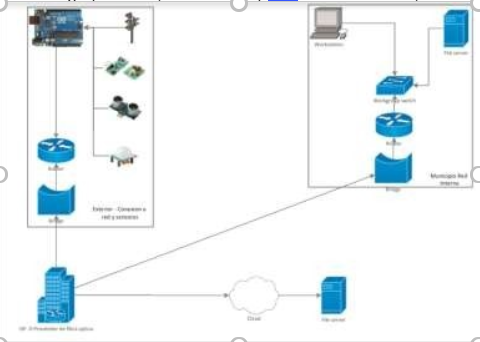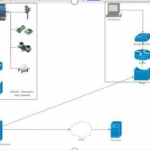
- Introducción
In control of transit in cities efficiently, quickly, secure and mainly in real time is one of the objectives presented in municipal public services policies. The lost time, the generated contamination (auditive and pollution) and the economic losses produced from a chaotic situation in transit, can be avoided or at least morayed from the use of For example, the Here Mobility company, based in the Dutch city of Amsterdam, proposes the idea of Smart Traffic Management . This system consists of the use of small lights, sensors and sensors integrated to the infrastructure. The company proposes a system used only to regulate transit. To do so, use sensors and traffic signals to monitor, control and respond to traffic conditions. The objectives proposed are to reduce congestion day by day, prioritise traffic based on real conditions of congestion,
pollution, give priority to the micros entering the intersections and using traffic lights to ensure the flow of buses across the city, and, in addition, improve response time in case of traffic accidents. Your method of implementation is by , a centralized control system , the setting of smart traffic lights and cameras . The application of big data and IoT makes the large-scale project an excellent choice for large-scale cities like New York [1] .
One of the projects obtained from the smartcity section of the Vienna page of the Government of Austria, implements four ideas on traffic lights that ⁇ think and communicate. ⁇ These are these.
- algorithms to recognize the desire to cross from the
- interconnected traffic lights,
- integration with systems
- and climate and environment sensors.
In September 2019 the ⁇ smart traffic lights ⁇ replaced approximately 200 traffic lights with crossing buttons. The algorithm raised was developed by TU Graz. consists of a camera that detects not only the passage of people, but, besides, records whether that person has the desire to cross. The connection with navigation systems indicates that traffic lights should not communicate with each other, but must pass information on to navigation devices and smartphones.
In that project and at a later stage, it is intended to place in the semaphore climate and environment sensors. These sensors will allow for statistical data to achieve an improvement in city air quality.
The Times magazine in a January 2019 presentation presents evolution, or perhaps the ⁇ intention ⁇ , of traffic lights over time. At work it is noted that only 3% of traffic lights are considered smart in the United States. Among other data presented, it is indicated that some systems are outdated, because they do not take into account pedestrians and cyclists. Plus, many of the sensors are under the streets and are affected by the weather.
The magazine presents a project that emerged at the Carnegie Mellon Institute where it intends to use a decentralised network of smart traffic lights equipped with radar, cameras and other sensors to manage traffic flows. The project, called Surtrac, deploys sensors to identify vehicle approximation, trajectory and speed, and thus adjust the duration of the green (or red) light of the area traffic lights. This allows you to handle in real time the volume of transit you have at every moment and not use mathematical predictions for it.
A last study analyzed is related to academic work, presented by students and teachers of the University of Lebanon in 2016 . Here is a smart traffic circuit, with two configurations, based on the pace of transition, and changing the time of the 4 traffic lights belonging to the same intersection. This is achieved by a programmable 16F877A microcontroller, an LCD screen, XBee transceiver, IR sensors, three-color LED lights that would replace the traffic lights.
- Case study
For the development of the proposed solution, some aspects considered essential for the project were analysed at first stage. Firstly, the solution promotes no changes in equipment or infrastructure of existing traffic lights. This situation is very important for a question of associated costs. A municipality that can implement an effective solution should not meet an excessive cost to implement it.
For this reason, and as second consideration, it is proposed to add a new functionality on the existing basis to make it more attractive to the final user.
An additional aspect would be good communication. It is expected that in the future not too far away municipalities will have or contract optical fiber. The use of it would create important advantages for the semaphores project, but, in addition, it will enable new ideas of SmartCity and IoT to be developed from a solid base and quality of service. While in the national context, the use of fibre optics seems still too far, a slow step has increasingly been achieved. In addition, the advent of 5G communication would allow better communication links, but at this point the associated costs can be more important.
2 . 1 How to make viable
The project must preserve the equipment available without generating very important additional costs. Under these two premises, the proposed solution was worked.
To answer the question raised, it is proposed that first carry out a quality and feasibility study, preventing the municipality from disbursing money into an innovative idea that later cannot implement. The solutions and requirements that will be necessary for the user to perceive and assess the proposed improvements should also be raised.
Taking into account the above, the aim is that once the project has been implemented there is an improvement for all stakeholders, from pedestrians, drivers, neighbors and even the same authorities that made it possible.
Pedestrians must see an improvement when the light allows them to cross. In addition, pedestrians with different capacities will be considered and inclusive solutions proposed.
Drivers will notice a decrease in the time of arrival and departure, reducing the famous ⁇ road rage ⁇ and encouraging the circulation to develop in a more comfortable and defrosted way. Time planning may be improved and the gain in time and therefore decrease should be considerable.
Finally, and equally important, it is environmental care. Efficient traffic control will have positive consequences in the care of our environment. A motor that this less idle time will generate less carbon emissions. A less altered motorist will generate less sound pollution.
- Solution ?
Figure 1 presents the generic scheme for the proposed solution. As can be seen, two elements are presented.
- the internal network
- the external sensor connection related to each light.
The connection between them is from a physical medium (optical net, as the graph raises, or eventually 4 or 5 G connection).
Fig. Fig . 1 .
- Network of the network
Each stoplight proposes the installation of the following:
- Switch for pedestrian crossing,
- Proximity sensors,
- Motion sensors.
The pedestrian crossing switch allows your activation by a passerby wishing to cross. In Argentina, a pedestrian crossing is allowed when the traffic light is with the red light, depending on the pedestrian crossing. This solution has an inconvenience, vehicles that fold are found with pedestrians crossing. This solution creates situations where the vehicle does not respect the pedestrian or that in the face of a certain high number of pedestrians the transit that it turns is affected. Use of this type of crossing buttons will enable you to activate a mode, where all pedestrians of all corners.
crossing, being all vehicles detained. This solution is implanted in large cities like Tokyo, Los Angeles and New York.
It should be taken into account, in addition, that there may be traffic lights intended only for the pedestrian crossing. This is, stop the traffic so that pedestrians cross the street without necessarily having an artery crossing in that place. These traffic lights must allow the passage of a person when required. I mean, lights that are on the green wave, until a button is pressed and not by waiting time. The placement of this type of switches has advantages from several perspectives.
Proximity sensors are an increasingly viable alternative to integrate people with different capacities. While having traffic lights that emit sounds for non-video people is already a reality in many municipalities; there are over-the-counter alternatives whose cost is not high. As an example, you can have proximity sensors for non-seer people. These sensors detect the pedestrian cane and generate the signal necessary for the light to go red, allowing the crossing. This way you don’t need to press a button to generate the event.
This solution can be adapted for people with reduced mobility capacity, obtaining the same functionality as the previous example. The RF modules of 433Mhz are very popular for their low cost, ease of use and their simple integration with a Arduino . The same work in emitter mode (FS1000A) and receiver (XY – MK – 5V)2 . You can connect receivers to key points where you are down for wheelchairs. Each wheel chair can count on an emitter, so as to approach an appropriate distance, the receiver will receive the transmitter signal and activate the signal for the event.
For the control of vehicle transit, the use of motion sensors is proposed. In this case, alternatives are type sensors (SENSOR PIR) (SEN0171) ⁇ Sensor Ultrasonido Hc – sr043 . This type of sensor can be used to measure the time a car is in custody. Another option is to use sensors located in the asphalt and by pressure to determine whether or not a car is in motion and for how long. Use of these sensors will allow you to evaluate the amount of cars detained and thus find an optimal time for the green light of the light.
An additional advantage of this type of sensor is to alert the traffic controllers in the municipality of malfunctioning equipment or failing the possibility of an accident. These possible situations are presented in case a sensor does not deliver changes for a prudential time.
These sensors will connect to a Arduino plate, with a Shield Mini Ethernet W5100, necessary for connection between the Mikrotik (hEX RB750Gr3) and the plate4.
Each semaphore panel must have a unique identification code. The arduino that will connect to the light panel will also be univocally identified. Each arduino will have connected a set of sensors as described above.
Figure 2 graphically describes the sensor array and arduino . It represents not only the position, but the operating arc of the
- Lower cost
- Cost less than 10 US$. 4 Cost below 15 US$.
working together with the ultrasound sensors, allowing for data to reflect the status of transit in real time.
Fig. Fig . 2 .
In order to maintain proper traceability of components each sensor should be identified in order to allow for more effective maintenance tasks. The intended connection is via category 6 UTP cables, to minimise the error in sending the respective signals. Figure 3 presents an equipment connection scheme and its link with the municipality.
As indicated above, the choice of hardware elements was made trying to minimize installation costs. While the necessary equipment (Arduino ⁇ sensors) is by traffic light, when the costs are analyzed, they stay below $100 per unit.
Fig. Fig . 3 .
- Servidores
One of the variants analyzed to manage the problem information is to have a physical server with four virtual machines. These virtual machines will be
- BackEnd: it is proposed to use a version of Ubuntu, with Java , Apache Maven and a BD
- FrontEnd: It is proposed to use Ubuntu with
- FreeNMS: it is a simple monitoring system, aimed at monitoring medium-scale infrastructures. This tool allows you to monitor various SNMPs and hosts graph the network map according to connections, and can create custom alerts on tools such as telegram.
- Backup


COMMENTS